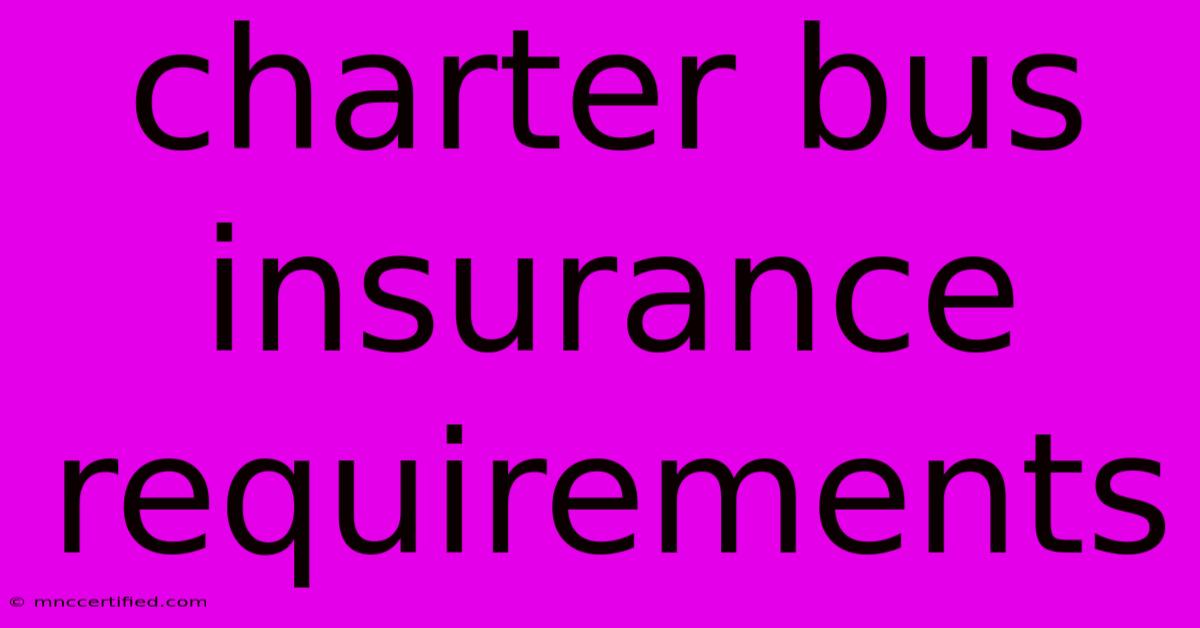Charter Bus Insurance Requirements

Table of Contents
Charter Bus Insurance Requirements: A Comprehensive Guide
Choosing the right charter bus for your group trip is only half the battle. Understanding and securing the correct insurance coverage is equally crucial for a safe and legally sound journey. This comprehensive guide will break down the essential charter bus insurance requirements, helping you navigate the complexities and ensure you're adequately protected.
Understanding the Need for Charter Bus Insurance
Before diving into specifics, it's vital to understand why charter bus insurance is non-negotiable. It's not merely a formality; it's a safety net protecting you, your passengers, and the bus company from potential financial devastation resulting from accidents, injuries, or property damage. Liability can be substantial, and without proper insurance, you could face crippling costs.
Key Areas of Coverage
Several types of insurance are essential when it comes to charter bus operations. Let's explore each in detail:
1. Commercial Auto Insurance: This is the cornerstone of any charter bus insurance policy. It typically covers:
- Bodily Injury Liability: Protects against claims for injuries or death caused by an accident involving the charter bus. The coverage amount should be substantial, reflecting the potential costs associated with multiple injuries.
- Property Damage Liability: Covers damages to other vehicles or property caused by the charter bus.
- Uninsured/Underinsured Motorist Coverage: Protects you if an accident is caused by an uninsured or underinsured driver. This is crucial, as it can cover your passengers' medical expenses even if the at-fault driver lacks adequate coverage.
- Collision Coverage: Covers damages to the charter bus itself resulting from a collision, regardless of fault. While often optional, it's strongly recommended.
- Comprehensive Coverage: Covers damage to the charter bus from events other than collisions, such as theft, vandalism, or weather-related damage. Again, while not always mandatory, it offers peace of mind.
2. Passenger Liability Insurance: This specifically addresses injuries or death to passengers riding the charter bus. This is essential and often has a higher coverage limit than bodily injury liability.
3. Umbrella Liability Insurance: This acts as an additional layer of protection, extending coverage beyond the limits of your commercial auto and passenger liability insurance. It's highly recommended, particularly for large groups or high-value trips.
4. General Liability Insurance: This covers non-vehicle-related incidents that could lead to liability claims, such as injuries occurring on the bus during loading/unloading or slips and falls.
Determining Your Specific Insurance Needs
The specific insurance requirements for your charter bus trip will depend on several factors:
- Number of Passengers: More passengers mean a higher potential for claims and, consequently, a need for greater coverage.
- Trip Length and Distance: Longer trips and longer distances increase the risk of accidents.
- Type of Charter Bus: Different bus sizes and features may influence insurance requirements.
- State Regulations: Individual states may have minimum insurance requirements for charter buses operating within their borders. Always check your state's specific regulations.
Working with Your Charter Bus Company
Reputable charter bus companies should carry adequate insurance. Don't hesitate to ask for proof of insurance and review the policy details. Verify the coverage amounts are sufficient and that the policy is current. Clarify who is insured—both the company and the passengers should be adequately covered.
The Importance of Compliance
Operating a charter bus without sufficient insurance is not only risky but also illegal in most jurisdictions. Non-compliance can lead to hefty fines and legal repercussions. Prioritize securing the right insurance to ensure a smooth and worry-free trip.
Conclusion
Securing appropriate charter bus insurance is a non-negotiable aspect of planning any group transportation. Understanding the different types of coverage, evaluating your specific needs, and verifying the bus company's insurance credentials are crucial steps towards a safe and legally compliant journey. By diligently addressing these insurance requirements, you'll safeguard yourself, your passengers, and the overall success of your trip.

Thank you for visiting our website wich cover about Charter Bus Insurance Requirements. We hope the information provided has been useful to you. Feel free to contact us if you have any questions or need further assistance. See you next time and dont miss to bookmark.
Featured Posts
-
Vernon Kays Radio 2 Future Uncertain
Nov 16, 2024
-
Watch Tyson Vs Paul Date Time And Streaming
Nov 16, 2024
-
Nations League Update Quarter Finalists Confirmed
Nov 16, 2024
-
Mike Tysons Children Jake Paul Bout
Nov 16, 2024
-
Mobile Home Insurance Pennsylvania
Nov 16, 2024